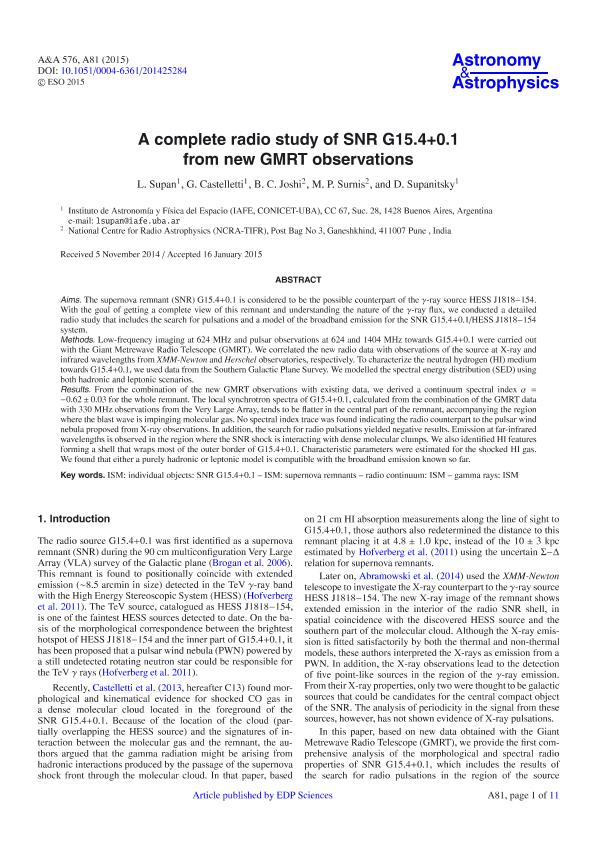Mostrar el registro sencillo del ítem
dc.contributor.author
Supán, Jorge Leonardo

dc.contributor.author
Castelletti, Gabriela Marta

dc.contributor.author
Joshi, B. C.
dc.contributor.author
Surnis, M. P.
dc.contributor.author
Supanitsky, Alberto Daniel

dc.date.available
2017-05-18T21:40:09Z
dc.date.issued
2015-01
dc.identifier.citation
Supán, Jorge Leonardo; Castelletti, Gabriela Marta; Joshi, B. C.; Surnis, M. P.; Supanitsky, Alberto Daniel; A complete radio study of SNR G15.4+0.1 from new GMRT observations; Edp Sciences; Astronomy and Astrophysics; 576; A81; 1-2015; 1-11
dc.identifier.issn
0004-6361
dc.identifier.uri
http://hdl.handle.net/11336/16699
dc.description.abstract
Aims. The supernova remnant (SNR) G15.4+0.1 is considered to be the possible counterpart of the γ-ray source HESS J1818−154. With the goal of getting a complete view of this remnant and understanding the nature of the gamma-ray flux, we conducted a detailed radio study that includes the search for pulsations and a model of the broadband emission for the SNR G15.4+0.1/HESS J1818−154 system. Methods. Low-frequency imaging at 624 MHz and pulsar observations at 624 and 1404 MHz towards G15.4+0.1 were carried out with the Giant Metrewave Radio Telescope (GMRT). We correlated the new radio data with observations of the source at X-ray and infrared wavelengths from XMM-Newton and Herschel observatories, respectively. To characterize the neutral hydrogen (HI) medium towards G15.4+0.1, we used data from the Southern Galactic Plane Survey. We modelled the spectral energy distribution (SED) using both hadronic and leptonic scenarios. Results. From the combination of the new GMRT observations with existing data, we derived a continuum spectral index alpha = -0.62 +- 0.03 for the whole remnant. The local synchrotron spectra of G15.4+0.1, calculated from the combination of the GMRT data with 330 MHz observations from the Very Large Array, tends to be flatter in the central part of the remnant, accompanying the region where the blast wave is impinging molecular gas. No spectral index trace was found indicating the radio counterpart to the pulsar wind nebula proposed from X-ray observations. In addition, the search for radio pulsations yielded negative results. Emission at far-infrared wavelengths is observed in the region where the SNR shock is interacting with dense molecular clumps. We also identified HI features forming a shell that wraps most of the outer border of G15.4+0.1. Characteristic parameters were estimated for the shocked HI gas. We found that either a purely hadronic or leptonic model is compatible with the broadband emission known so far.
dc.format
application/pdf
dc.language.iso
eng
dc.publisher
Edp Sciences

dc.rights
info:eu-repo/semantics/openAccess
dc.rights.uri
https://creativecommons.org/licenses/by-nc-sa/2.5/ar/
dc.subject
Ism: Individual Objects: Snr G15.4+0.1
dc.subject
Ism: Supernova Remnants
dc.subject
Radio Continuum: Ism
dc.subject
Gamma Rays: Ism
dc.subject.classification
Astronomía

dc.subject.classification
Ciencias Físicas

dc.subject.classification
CIENCIAS NATURALES Y EXACTAS

dc.title
A complete radio study of SNR G15.4+0.1 from new GMRT observations
dc.type
info:eu-repo/semantics/article
dc.type
info:ar-repo/semantics/artículo
dc.type
info:eu-repo/semantics/publishedVersion
dc.date.updated
2017-05-18T15:36:48Z
dc.journal.volume
576
dc.journal.number
A81
dc.journal.pagination
1-11
dc.journal.pais
Francia

dc.journal.ciudad
Paris
dc.description.fil
Fil: Supán, Jorge Leonardo. Consejo Nacional de Investigaciónes Científicas y Técnicas. Oficina de Coordinación Administrativa Ciudad Universitaria. Instituto de Astronomía y Física del Espacio. - Universidad de Buenos Aires. Facultad de Ciencias Exactas y Naturales. Instituto de Astronomía y Física del Espacio; Argentina
dc.description.fil
Fil: Castelletti, Gabriela Marta. Consejo Nacional de Investigaciónes Científicas y Técnicas. Oficina de Coordinación Administrativa Ciudad Universitaria. Instituto de Astronomía y Física del Espacio. - Universidad de Buenos Aires. Facultad de Ciencias Exactas y Naturales. Instituto de Astronomía y Física del Espacio; Argentina
dc.description.fil
Fil: Joshi, B. C.. National Centre for Radio Astrophysics; India
dc.description.fil
Fil: Surnis, M. P.. National Centre for Radio Astrophysics; India
dc.description.fil
Fil: Supanitsky, Alberto Daniel. Consejo Nacional de Investigaciónes Científicas y Técnicas. Oficina de Coordinación Administrativa Ciudad Universitaria. Instituto de Astronomía y Física del Espacio. - Universidad de Buenos Aires. Facultad de Ciencias Exactas y Naturales. Instituto de Astronomía y Física del Espacio; Argentina
dc.journal.title
Astronomy and Astrophysics

dc.relation.alternativeid
info:eu-repo/semantics/altIdentifier/doi/http://dx.doi.org/10.1051/0004-6361/201425284
dc.relation.alternativeid
info:eu-repo/semantics/altIdentifier/url/https://www.aanda.org/articles/aa/abs/2015/04/aa25284-14/aa25284-14.html
Archivos asociados
